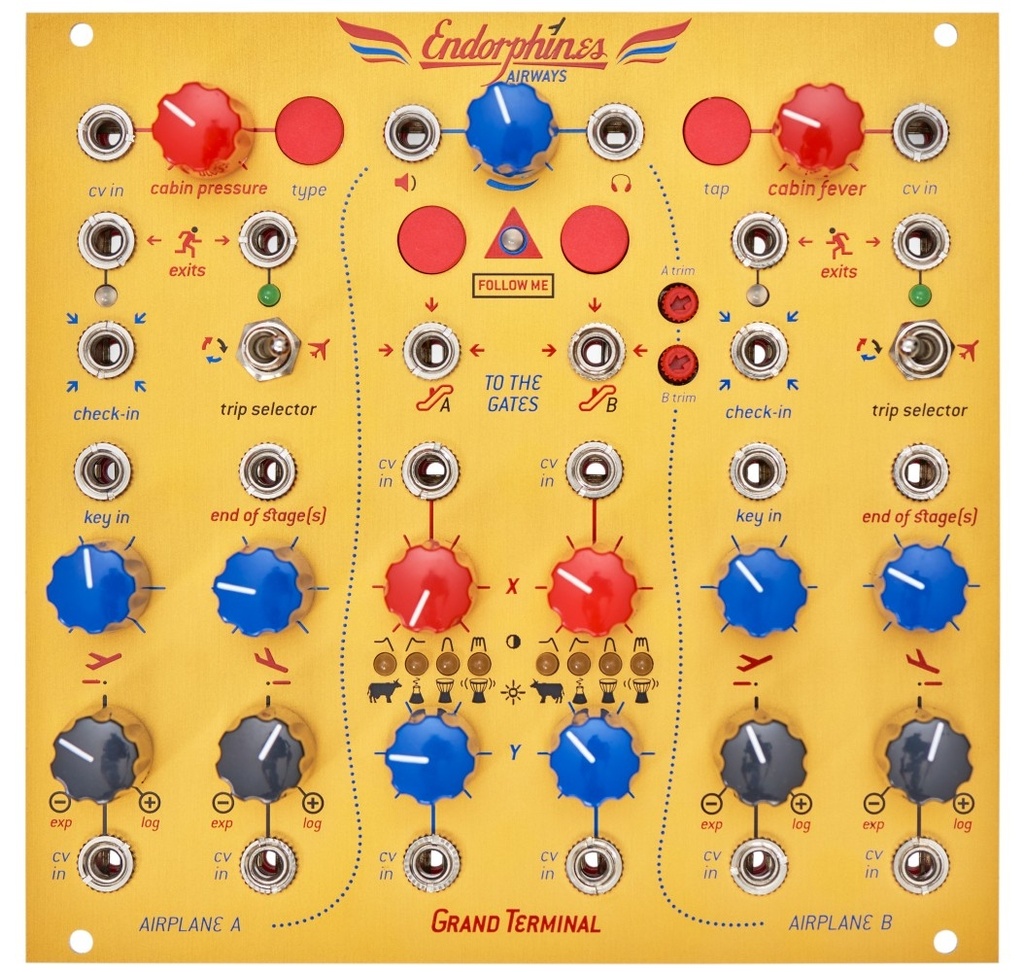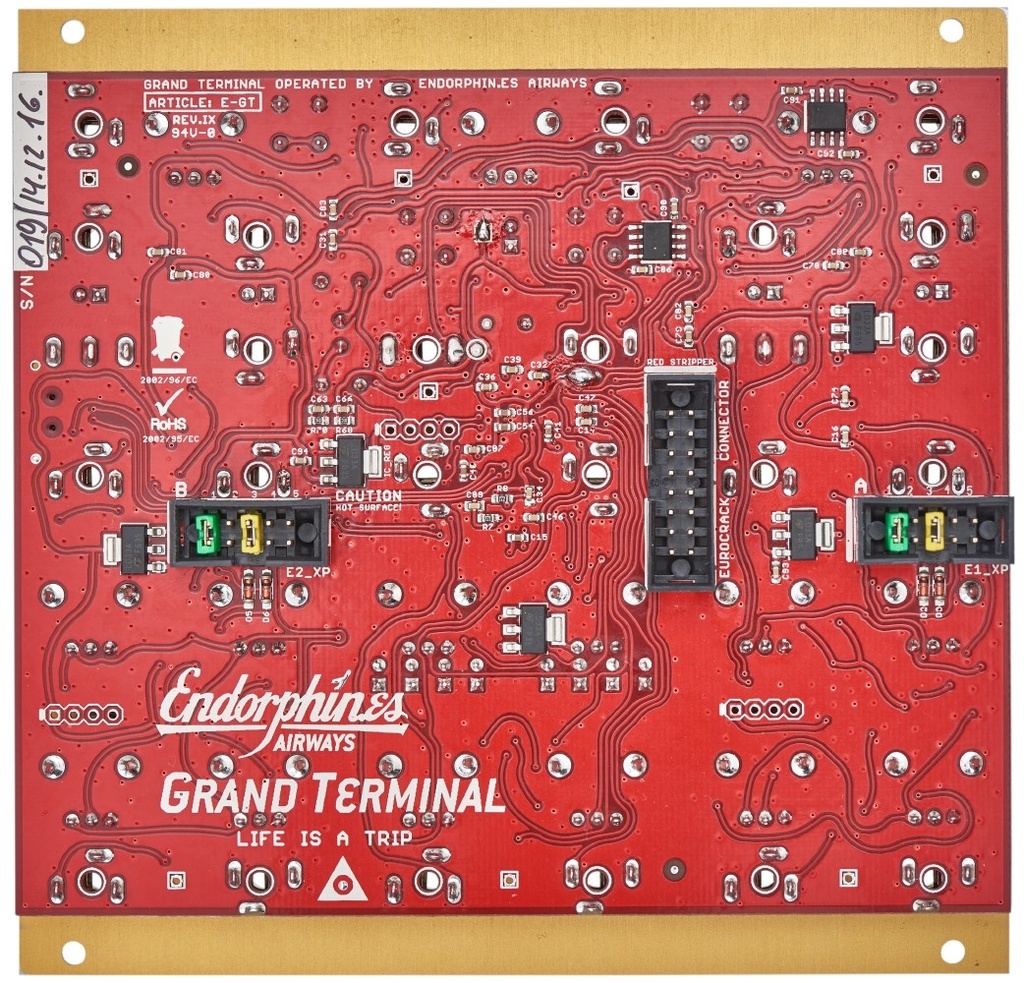The Grand Terminal is a digital multipurpose module for ambitious sound designers. It contains two function generators, which can be used as envelopes, LFOs or VCOs, two filter channels with eight modes of operation, mixing and routing options as well as a multi effects unit. Considering this feature set, it is safe to say that the Grand Terminal is more than the sum of its parts. It is a complete synthesizer voice, which can also be used as a dual mono or stereo filter plus reverb, delay respectively chorus processor and modulators. Despite its high complexity, handling the unit is easy as pie. The sound is crystal clear and, thanks to all the filter types and effect algorithms, very versatile. Simply put it in your modular and take off!
The Grand Terminal is based on an ARM M4 DSP. Audio signals are processed with a resolution of 16 Bit and 48 kHz. Just like its predecessor, simply called Terminal, the enhanced Grand version utilizes terms familiar from air transportation to explain componentry and functions.
The filter channels, referred to as Gate A and B, can be used in parallel or serial. Additionally, there is a link mode for treating stereo material. With this option active, the knobs of Gate A are used to control both filter cannels.
The Grand Terminal’s signal flow brings channel strips of mixing consoles to mind. Right behind the inputs, there are gain sections with trim potentiometers, which can be used to calibrate the circuit to work with other modules, CD and MP3 players or professional studio equipment. Signals that exceed the headroom are soft clipped to prevent unwanted distortion. The connector of Gate A is normalized to Gate B for easy parallel processing.
Following the gain sections, the filters offer an assortment of eight filter types. Each can be edited in two parameters called X and Y. Thanks to CV inputs, modulations are possible as well. In detail, the following filter types and parameters are included in the Grand Terminal:
- Transistor Ladder Filter: A -24 dB per octave low-pass filter, modeled after Moog's Minimoog. (X: Cutoff / Y: Resonance)
- Diode Ladder Filter: A -18 dB per octave low-pass filter inspired by Rolands TB-303 and the EMS Synthi A. (X: Cutoff / Y: Resonance)
- Vactrol Lo-Pass Gate: Think Buchla -12 dB per octave low-pass gate, but with added control over its decay time. Values from 120 milliseconds to four seconds are possible. (X: Cutoff / Y: Decay)
- Resonant Vactrol Lo-Pass Gate: A variation of the low-pass gate described above. This version comes without an editable decay parameter. Instead, it features adjustable resonance. (X: Cutoff / Y: Resonance)
- State Variable Low-Pass Filter: This -12 dB per octave low-pass filter sounds like a mixture of Oberheim SEM and Korg MS-20. (X: Cutoff / Y: Resonance)
- State Variable High-Pass Filter: Similar to the above mentioned low-pass, but with high-pass characteristic. (X: Cutoff / Y: Resonance)
- State Variable Band-Pass Filter: Similar to the above mentioned low-pass, but with band-pass characteristic. (X: Cutoff / Y: Resonance)
- Comb Filter: A comb filter for creating phaser and flanger alike effects. (X: Cutoff / Y: Resonance)
After passing the filters, audio material travels through pan- and volume sections. These stages are adjustable with the X and Y knobs as well. The user can switch between filter and mixing parameters by pressing the filter buttons for more than one second. High volume adjustments, starting at about 70 percent of the correspondent knob’s range, add distortion to sounds.
The Grand Terminal’s multi effects processor comprises eight algorithms, in detail four reverbs, three delays and a chorus. Each program can be edited in two parameters, using the “Cabin Fever” potentiometer. Switching between the two parameters is done by pressing the Tap button for about one second. Furthermore, this control element can be employed to set a clock for delay algorithms. With the Spring reverb program active, the user is able to “pluck” the virtual springs. The “Cabin Pressure” knob adjusts the mixture of dry and wet audio material. Two control voltage inputs allow modulations and other manipulations of the “Fever” and “Pressure” parameters, depending on the selected algorithm. In detail, the effects unit offers the following programs and parameters:
- Hall reverb (Parameters: Decay / Frequency of the included high-pass filter.)
- Shimmer reverb (Parameters: Decay / Mixture of pitch-shifter and reverb signals.)
- Room reverb (Parameters: Decay / Stereo spread)
- Spring reverb (Parameters: Decay / Decay of spring excitement resulting from using the Tap button or CV input.)
- Ping-Pong delay (Parameters: Feedback / Divider for the delay’s frequency, which was entered via Tap button or incoming CV clock before.)
- Tape delay (Parameters: Tape speed / Divider for the delay’s frequency, which was entered via Tap button or incoming CV clock before.)
- Chorus (Parameters: LFO speed / Modulation depth)
Behind the multi effects processor, there is a final volume control, followed by mono and stereo outputs to tap off audio material.
The function generators of the Grand Terminal, Airplane A and B, are usable as AD or A(S)R envelopes. Attack and decay / release can be edited in both their length (one millisecond to ten seconds) and curve shape (exponential to linear to logarithmic). Using the Airplane’s control voltage inputs, it is also possible to modulate one or both values of each envelope stage. The curve potentiometers then work as attenuators. Which parameters are influenced can be chosen via jumpers on the back of the module. Besides unipolar and bipolar CV outputs, the Airplanes also feature end of stage connectors. They emit a trigger signal each time the take off (attack) and / or landing phase (decay / release) is completed. Again, jumpers on the back of the module set the exact mode of operation.
Alternatively to utilizing the function generators as envelopes, they can be employed as LFOs respectively band-limited VCOs. In this mode, the attack and decay parameters set the shape of the waveform. Using the key in connector, it is possible to play the Airplanes correctly across 6.5 octaves.
Handling the Grand Terminal is a breeze. However, if the user does get lost at some point, he / she can press a key combination to reset the module.
Specifikáció: Grand Terminal
| Megvalósított funkciók | VCF, VCA, Effect, CV source |
| Szélesség (HP-ben) | 26 |



